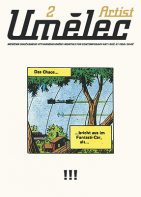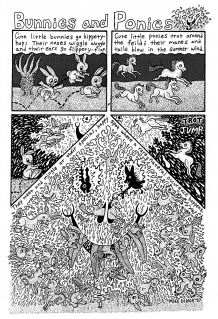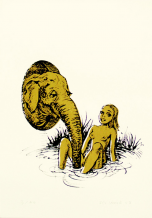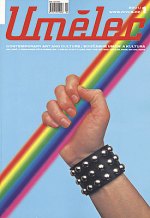| Časopis Umělec 1998/2 >> Kdo vyhrál v Tate 20.000 liber? | Přehled všech čísel | ||||||||||||
|
|||||||||||||
Kdo vyhrál v Tate 20.000 liber?Časopis Umělec 1998/201.02.1998 Petr Pavlík | cena | en cs |
|||||||||||||
|
The French House of Soho is a place where Brit Pop stars occasionally meet with other personalities who just happen to show up in London trying, too, to become popstars for just a short moment.
After Lawrence Weiner’s Towards Motion opening at the Canary Wharf, this was where the after-party took place as well. Tracey Emin showed up bringing with her the neverending moaning over the fact that she had not been nominated again for the 1997 Turner Prize. Her main reasons included her proletarian descent which is more than funny. Frustration of unsatisfied Tracey The Social Case naturally prepared the grounds for a media frenzy: who will pick up the cheque this year? The first runner-up was Christine Borland, a conceptual thirty-something artist who is charmed by various types of violence. She made color photographs of watermelons smashed on stairs and guns tucked into jackets which she also showed in the British Council Window Gallery in Prague. Her interest focuses on collecting various things, objects and human fates. In the Tate, she showed a “museum collection of historical objects“. She reconstructed a human backbone out of a former backbone by placing it on a glass panel and showering it with some powder (flour, sugar or whatever). Then she took the bones away and created “an even more fragile and strange“ backbone than we can imagine. She places the panels horizontally in various heights and positions illuminating them with a spotlight. The resulting image is then projected on a wall or a floor. Christine Borland is Scottish and she is represented by the “almighty“ Lisson Gallery. Most people had expected that a representative of this stable was to win but they were wrong. Perhaps this was because Douglas Gordon, who won the Prize two years ago, is also Scottish. Cornelia Parker, around forty, was the oldest of the Turner Prize runner-ups. Her interest lies in the state of things after destruction. At the Tate, she presented an object which consisted of pieces of some burnt-down church. The pieces were tied to transparent threads and hung from a ceiling like Ivan Kafka’s arrows (in a technical sense). The entire object was placed in a levitating cube. I know of one other similarly amusing piece by Parker. She built a wooden shed, had it blown up and then followed the above-mentioned process with burnt and destroyed pieces to create a unique outcome. Parker also collects hairs from Sigmund Freud’s chairs and pillows and inserts them in between two pieces of glass, etc. The most interesting thing about her part at the Turner Prize were the arguments about why she should be the one to win: “She is the oldest and she is represented by the solid Frith Street Gallery in Soho“. When I was leaving the opening and telling people of my tip for the winner, I just heard a very strict “never“ behind me. Then we were told that Angela Bulloch would make the right queen for this contest. Again, very conceptually-oriented artist. I don’t think her previous and current activities are very different. Her ideas use technique and she likes to grant them the appearance of simple design. Do you know her sexy dawning balls? Or a piece she also showed at the Tate which consisted of automatically painted picture. It was controlled by some sort of accidental impulse. I didn’t really get the idea behind this piece but I know other of her works: a painting hung in a restaurant with scribbled geometrical curves on it. One can see a mechanism in the painting which instegates this operation. The impulses are generated by opening and closing door to the restaurant’s bathroom. Bulloch also plays guitar in a band as is typical for London. She also exhibited a large soft chair (for children?) and when you sit on it, it makes some noise. She also pasted some texts on the walls with some scribbles over it and something blinking in the corner. Two Italians who call themselves Robert Prime run one of the most interesting galleries in London where you can see some non-British art but they also exhibit Angela Bulloch. And who is the winner? Gillian Wearing’s work looks like some strange social documentary. One of her better-known pieces consisted of stopping people on the street and asking them: “What do you feel right now?“ She then demanded that they write their answers on a piece of paper which is also part of her work. The result looks like this: a photo of a person holding a piece of paper with the answer, for example “I’m desperate“. She also placed ads looking for people to participate in various activities. At the Tate, she presented two video works. The first “action“ piece, called “Sasha and Mom“ (which was also part of the City Projects Prague in the mid-90‘s), was probably about trust. A mother and a daughter are having some sort of fight but we don’t know whether they really fight or hug each other. The film is shown backwards. Her other video, “60 Minutes of Silence“, looks like a film projection of a graduation snapshot at a police school. It is a very strong image which needs no explanation or hints. Before I forget, G.W. is represented by Interim Art in East London owned by Maureen Payley. The gallery is only open on Fridays and Saturdays but it is very flexible. And where were the men? Mark Wallinger is a natural part of Brit Pop. At the end of the 80‘s and beginning of the 90‘s he ran a studio at the Goldsmith College, which G.W. attended. Mark and Gillian have lived together for several years so it’s no wonder that Mark is grinding his teeth these days as he was also nominated for the Prize but he was then competing with other people. At that time, Damien Hirst was the winner. This year, Gillian Wearing got the 20.000 pounds but for many people who know the background, Mark Wallinger was the winner. Summary 1997 Turner Prize was quite boring and dry despite the fact that the “right“ winner was selected. I think that there are many more interesting places in London than the Tate Gallery. It’s a pity that Czech curators stick with tired-out Brit Pop (there is an exhibition planned at the Modern and Contemporary Art Collection in addition to the current exhibition at the Municipal Library) as it lost its momentum. London is no longer shaken by the monstrous Damien Hirst or the arm-chair artists, the Chapman brothers, and Sensation-like exhibitions. What is hip in marginal galleries is Easy, Trashy, Cheap Style. Watch out for names like Phill Allen, Gary Perkins and Frankie Sinclair who we will admire when Venice or other established intitutions approve them.
01.02.1998
Doporučené články
|
|||||||||||||
|
04.02.2020 10:17
Letošní 50. ročník Art Basel přilákal celkem 93 000 návštěvníků a sběratelů z 80 zemí světa. 290 prémiových galerií představilo umělecká díla od počátku 20. století až po současnost. Hlavní sektor přehlídky, tradičně v prvním patře výstavního prostoru, představil 232 předních galerií z celého světa nabízející umění nejvyšší kvality. Veletrh ukázal vzestupný trend prodeje prostřednictvím galerií jak soukromým sbírkám, tak i institucím. Kromě hlavního veletrhu stály za návštěvu i ty přidružené: Volta, Liste a Photo Basel, k tomu doprovodné programy a výstavy v místních institucích, které kvalitou daleko přesahují hranice města tj. Kunsthalle Basel, Kunstmuseum, Tinguely muzeum nebo Fondation Beyeler.
|






























 23.05.-17.06.2017 STU MEAD & MIKE DIANA IN PARIS
23.05.-17.06.2017 STU MEAD & MIKE DIANA IN PARIS
Komentáře
Článek zatím nikdo nekomentovalVložit nový komentář